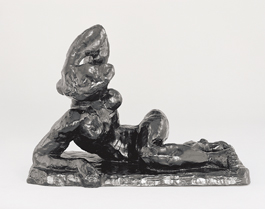home | metro silicon valley index | the arts | visual arts | review

The Cone Collection; © 2007 Succession H. Matisse, Paris/Artists Rights Society (ARS), New York
Curves: Henri Matisse's
1907 bronze 'Reclining Nude I (Aurora)' shows the artist's love of
the female form.
Shapely
SFMOMA's Matisse show revels in flesh, fantasy and the great curve
By Richard von Busack
IF THERE is such a thing as the summer movie, then one needs the summer art show as a counterpoint. Matisse: Painter as Sculptor, now on display at San Francisco's Museum of Modern Art, is the closest thing to a trip to the beach without being there.
Henri Matisse's work in three dimensions is less well known than his championing of color and flatness in his paintings. Said the artist Kandinsky—quoted in Jack Flam's Matisse and Picasso—"Matisse—color. Picasso—form. The two great painters toward one great goal." Matisse made a finer distinction when differentiating himself from the sculptor Aristide Malliol. According to Matisse, Malliol was interested in volume, where he, Matisse, was interested in arabesques, "like a Renaissance artist."
The italics are mine, because I don't quite understand what he meant. Certainly, Matisse's paintings contain arabesques by the pound; he famously patterned them with lightly drawn lines like unstrung Arab calligraphy. But maybe what Matisse meant by arabesques is the way his sculptures abstract everyone's favorite double set of S-curves. Draw an hourglass in the air with your hands, like schoolyard boys used to do, and you'll see what I mean.
Finding the curves was essential in Matisse's favorite poses of his odalisques. Their arms are cozily bent above their heads, offering their breasts to the passing pasha. In standing sculptures, he exaggerates the S-curve of the waist with one propped-up foot; the plaster Madeleine 1 (1901) is so deliciously curvy she looks like a prototype for Tex Avery's cartoon babe "Red."
"I sculpted as a painter. I didn't sculpt as a sculptor." Matisse challenged himself to get all angles at once, as in his duet of a pair of women, Two Negresses. His famous 1907 painting Blue Nude ("Ooh, la, la!" exclaimed Gertrude Stein's concierge's kid when he saw it) depicts a girl in such a twist that she almost shows both sides of her body at once. Flam argues that Matisse—unlike Picasso—never mastered this duo-vision technique, but that he tried hard. This show of some 50 sculptures proves that Matisse was a vigorous sculptor who passed that get-'er-done ethos on to his students: "Build up your figures as a carpenter does a house."
We see aspects of Matisse's education, demonstrated by Antoine-Louis Barye's 1850 statue of a jaguar lunching on a rabbit. In Matisse's deliberately rougher copy, circa 1900, the clearly delineated bones of the cat in Bayre evolve into a smooth hump of muscle.
As in SFMOMA's Picasso and American Art show, one harbors the unworthy thought that the show's theme is merely a hook to haul out some damned good paintings. You owe it to yourself to see the strawberry-ice-cream-colored 1935 Pink Nude. Even more ravishing is the 1926 Odalisque With a Tambourine, a slim, oval-head figure sitting, one long leg up, on a striped satin chair.
This show proves Matisse's mettle as a sculptor with The Back I–III bronzes taken from the UCLA Sculpture Garden. They are huge dorsal trunks—women far along the way to becoming sycamores. Facing them are three heads and two busts, all based on Matisse's model Jeanette Vaderin. In the end, the slight bulge of Vaderin's forehead inflates into Olive Oyl globes of hair and a sharp pointed beak. Nearby, is Picasso's Head of a Woman done after he saw Jeanette II at a Paris show; it continues the abstraction into monstrosity: lolling Muppet eyeballs and a nose the size and shape of a calf's head.
Matisse's deceptively simple art sometimes gets slandered as decorative. The show expands our ideas of Matisse's gifts without changing the notion of the force of his personality—of his energy, his love of the body and, yes, his love of tropical colors. The show concludes with the originals for Matisse's exuberant 1947 Jazz, in which the artist laid out sculptural paper-cut shapes of an undersea world, the foliage of fantastic trees and figures liberated from the entire crush of gravity.
Matisse: Painter as Sculptor runs through Sept. 16 at the San Francisco Museum of Modern Art, 151 Third St., San Francisco. (415.357.4000)
Send a letter to the editor about this story.
|
|
|
|
|
|